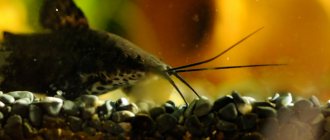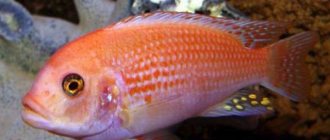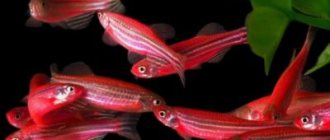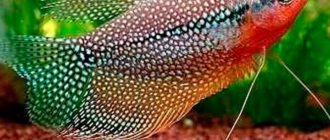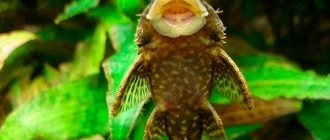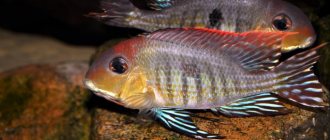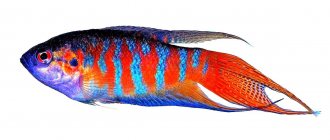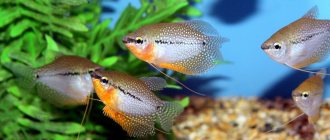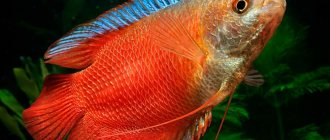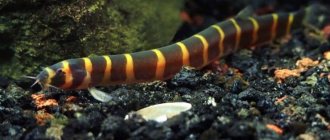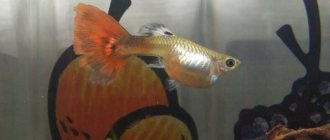Description
Beautiful chromis have an elongated body measuring 12–15 cm. The sides, fins and body are covered with greenish or bluish round spots. The appearance of the handsome varieties differs in the location of dark spots on the body. Everyone has one in the middle of their torso. The second spot near the anus of a two-spotted beauty. On the gills of hybrid species. In sexually mature individuals they sometimes disappear.
Most often the color is red. Shades from bright carmine to pink-orange. The back of handsome men is usually dark olive. The sides are greenish-pink.
The dorsal and anal fins are pointed. The caudal fin is rounded. The dorsal is long, occupies almost the entire back. The beauties are also called pearl cichlids, because of the blue luminous spots that cover the body and fins.
Features of behavior
Chromis handsome (hemichromis, red cichlid) has an aggressive character. They tend to undermine the soil and gnaw plants. Only hard-leaved species are selected.
When moving into a new aquarium, it takes 15–20 days to get used to it. During the adaptation period they are fearful. Housing conditions should be similar to the previous one.
After getting used to it, they divide the territory and drive away strangers. Even members of their own species. Therefore, there must be shelters in the reservoir where growing males and females can hide from mature individuals.
When they spawn, belligerence increases. During spawning, the partner sometimes kills the weak one. There are also peaceful-minded individuals. But the look is very aggressive.
Lifespan
The average lifespan of the chromis beauty fish in captivity is 4–5 years.
Habitat
The beautiful chromis naturally lives in the rivers of Central Africa , where it can be found in the basins of the Nile, Niger, Congo (except for the Katanga and Kasai region), in the Central African Republic, the Republic of the Congo and the Democratic Republic of the Congo.
The fish likes to settle near the shores of lakes and rivers with developed coastal vegetation and a high oxygen content in the water.
Did you know? An aquarium is a great way to meditate and relieve stress. To calm your nervous system, sit near the aquarium and watch the smooth movements of fish and aquatic vegetation for 20-30 minutes in complete silence. And don't think about anything!
How to keep Chromis handsome
Chromis is a handsome aquarium fish, maintenance and compatibility. However, due to their attractive appearance, they are often purchased by beginners and placed in a community aquarium along with small fish. Naturally, the chromis will destroy them all, mistaking them for food.
Arrangement of the aquarium
Chromis aquarium fish are distinguished not only by their large size, but also by their activity. That is why a large spacious aquarium of 200 liters is required. It is also worth considering that fish belonging to this species are territorial and quite aggressive. Since individuals like to hide, you will need to take care of the availability of shelters. To do this, you can place driftwood, coconuts, pots, and caves in the aquarium.
Water parameters
Hemichromis hemichromis, like any other cichlids, needs clean water. They prefer to live in soft water, so a suitable parameter is 12 dGH. However, they can also get used to hard water. The water temperature is maintained between +25 and +28 degrees.
Maintenance and care, arrangement of the aquarium
The optimal size of an aquarium for one pair of fish starts from 70 liters. The design must include a sufficient number of shelters (caves, snags, etc.) and areas with dense vegetation. Chromis red often digs into the ground, so use a sandy, fine gravel substrate; for the same reason, live plants are planted in pots to avoid tearing them out or damaging the roots. Water conditions have slightly acidic pH values with low to medium hardness (dGH index). To maintain a high concentration of dissolved oxygen, provide an effective water aeration system and regularly clean the soil of organic waste, which, during the decomposition process, actively absorbs it through chemical reactions.
Kinds
There are four popular types of fish that are classified as handsome.
- Hemichromis Bimaculatus. Two-spotted, characteristic dark spots near the caudal fin.
- Hemichromis Guttatus. Tall-bodied, without dark spots, like the two-spotted one.
- Hemichromis lifalili. Different form of dorsal fin, no spot near the tail. This species is considered a real beauty of chromis. It is more peaceful than the tall-bodied or two-spotted.
- Hemichromis Bimaculatus II. An artificially bred subspecies. Very bright red color.
Species interact and interbreed. Therefore, hybrids of unknown origin are found in stores. Beautiful, bright colors and characteristic dark spots are characteristic of all species.
Caring for young animals
The speed of development depends largely on good feeding. The conditions of detention do not differ from those in which the parents live. Feeding begins with zooplankton, gradually moving to daphnia and finely chopped tubifex.
Even when they are very young, the fry of the handsome chromis already show their aggressive disposition. As they grow up, you need to constantly separate the weakest individuals, otherwise they will be killed by their brothers and sisters. By the age of 6-7 months, it is necessary to prepare future housing for all fish so that, having become sexually mature, they do not fight for the redistribution of territory.
Following these simple rules will give you the opportunity to observe the life of the brightest representative of the cichlid family day after day. Having become acquainted with them, many hobbyists switch their aquariums to monopoly mode, where one or several pairs of handsome chromis live.
Reproduction
Breed beauties at home in a separate large-volume aquarium of 100 liters or more. It's called spawning. It is possible in general, but you need to protect the fry and neighbors in the aquarium, because during the spawning period, chromis are more aggressive than usual. The period of sexual maturity in the red cichlid occurs at 6–9 months.
Sex differences
It is difficult to visually distinguish a male from a female. Sex differences are not clearly expressed. Males have brighter colors and are larger in size. Female chromis have a more rounded abdomen.
Pair formation
When breeding beauties, the creation of a pair plays a major role. Because if the partners don’t get along, they can kill each other. The couple is created forever and remains monogamous. Buy a pair that has already been created in the store.
If you are planning to raise handsome dogs on your own and create a couple, then start by getting to know each other. For example, in an aquarium through a barrier or glass. When the male and female do not show aggression towards the partner, then they can proceed to spawning.
Preparing for spawning
Place large flat stones on the ground in the aquarium. The eggs will be laid there. For stimulation, increase the water temperature to 27–29°C. The medium must be neutral or slightly acidic.
Spawning
When the pair has formed, spawning begins. In males the color becomes brighter. And blue or green spots begin to glow. But not for all individuals. He begins to form shelters, dig holes, and clears flat stones of debris.
It is important that the female is ready for spawning. If she is not ready, move her away temporarily. Otherwise, it may become a victim of the male. Watch the couple especially carefully.
Breeding
For a fish like the handsome chromis, reproduction begins with the choice of a permanent partner. For productive breeding, it is advisable to buy a school of 6-8 fish and wait until permanent pairs form. This can be determined by the fact that the fish spend most of their time alone. After a pair is formed, the remaining individuals are separated to avoid quarrels and fights.
Setting up a spawning tank
For a spawning tank, choose an aquarium of 100 liters or more.
Preparing the container:
- before filling, the future spawning tank is washed with running water;
- water is poured into soft, slightly acidic water;
- the soil is not covered;
- Several large flat stones are placed on the bottom and a couple of artificial grottoes, caves or ceramic pots are installed (they are placed sideways).
Spawning
The formed pair is placed in the prepared spawning tank. Parents choose a stone for laying and carefully clean it of debris. Then the female lays about 500 eggs on the prepared surface and remains nearby, the male fertilizes the eggs and begins to actively guard the territory.
Caring for offspring
The larvae appear after 3-5 days. Parents collect the fry in their mouths and move them to another, safer place, the area around which is carefully protected until the babies begin to swim on their own.
After the fry begin to feed on their own and swim well, it is recommended to transplant them into a separate aquarium. It has been noticed that parents remember their babies and can distinguish them from the fry of other fish of their species.
Hemichromis are responsible parents, caring for the fry until they become independent
If you laid eggs in a community aquarium
Hemichromis can also spawn in a community aquarium, but no matter how the father protects the fry, the offspring are most often eaten by other underwater inhabitants. Therefore, after the couple begins to look for a place to lay eggs, the fish must be immediately placed in a spawning tank prepared in advance.
What to feed Hemichromis handsome
The diet should include:
- protein - live food is well suited for this: bloodworms, tubifex, pollock fillet, shrimp, etc.;
- microelements, minerals and vitamins - the intake of these substances into the body is ensured by dry specialized mixtures and scalded lettuce leaves.
The feeding regimen for adult fish is standard for predators: once a day with a small portion, which the fish will eat within 7-10 minutes. Young animals are fed more often - 2-3 times a day. Plant foods and dry food should predominate. The abundance of protein in fish can cause obesity. Once a week you need to have a fasting day and go without feeding.
Intestinal parasites in cichlids: symptoms, cause, treatment
The only disease that can seriously reduce a flock is cryptobiosis, caused by the parasite Cryptobia. Typical signs of infection in Malawian cichlids will be:
- darkening of the skin;
- bulging eyes;
- lack of appetite;
- lack of mobility;
- blindness.
In Tanganyika, only food refusal and a bloated abdomen are observed. The fry of lake cichlids die out almost completely within 1-2 weeks.
Regular ornidazole or secnidazole, sold in pharmacies, will help cope with intestinal infections. The medicine is thrown into a general aquarium once (1 tablet per 150 l). In advanced cases, repeat after 12 hours. Before the procedure, the fish should not be fed.
To give the disease a worthy rebuff, throw up to 5 tablets per 100 liters into a separate tank. The effect of the drug lasts 4 hours. During this time, the hungry fish will swallow the food along with the dissolved drug, and it will enter the intestines. If the cichlid's belly is swollen and it does not take food, the medicine is injected into the intestines with a syringe. In this case, the Canadian drug Tricaside is used. It is also added to frozen food (3 capsules per 1 kg) as a prevention of intestinal infections.
Chromis diseases
The list of diseases is standard for aquarium fish:
- bacterial infections;
- viral infections;
- parasites.
Since chromis, which are kept in good conditions, have good immunity, they rarely get sick. Signs of diseases include:
- violation of the integrity of the skin - scales bristle or fly out;
- cloudy, whitish spots on the sides;
- frayed fins (may be a result of fights with other fish);
- lethargy, poor appetite;
- cloudy eyes, whitish flakes around the eyes;
- open mouth, everted gills.
Disease prevention involves maintaining the correct water parameters, feeding regimen and cleanliness of cleaning equipment. New fish are usually not added to adult chromis, but if necessary, all fish must first undergo quarantine.
Tuberculosis in cichlids: symptoms, cause, treatment
With this disease, caused by bacteria, small nodules appear in the internal organs of fish. When they break down, they form ulcers. In parallel, fin rot may occur. Tuberculosis may be suspected:
- general apathy;
- fading of color;
- decreased appetite;
- thinness;
- ulcers on the skin.
Fish become infected by eating the remains of deceased relatives. Tuberculosis in fish is incurable. Therefore, you should immediately remove all dead and suspicious fish, without waiting for the rest to start eating them.
Adviсe
Use plastic pipes for shelters. Instead of living plants, install artificial ones. When the fry grow up, move the weak and small ones separately so that they do not go to feed.
Compliance with the rules of care, proper nutrition, competent neighborhood - the three foundations on which a handsome man can live a full life and delight you with his bright, beautiful appearance.
Sources
- https://vplate.ru/akvariumnye-rybki/vidy/hromis-krasavec/
- https://top-cat.ru/chem-kormit-malkov-hromisa-krasavca/
- https://rybkies.ru/rybki/hromis-krasavec.html
- https://akvariumfish.ru/akvariumnye-rybki/hromis-krasavets
- https://aquazhizn.ru/vidy-rybok/hromis-krasavec
[collapse]
Compatibility
The beautiful Chromis is an aggressive cichlid that becomes even more aggressive during spawning. It can only be kept with large tetras, such as the Congo tetra, Sumatran barbs, synodontis catfish, chain-mail catfish, clown botia, and other African cichlids, such as the lion-headed cichlid, aulonocara, African peacock, and mbuna.
Chromis beauties are usually kept in pairs, but do not try to combine two adult fish - the weaker one will be killed. Usually several juvenile fish are introduced, of which at least one pair will be formed. The resulting couple is sent to live separately.
